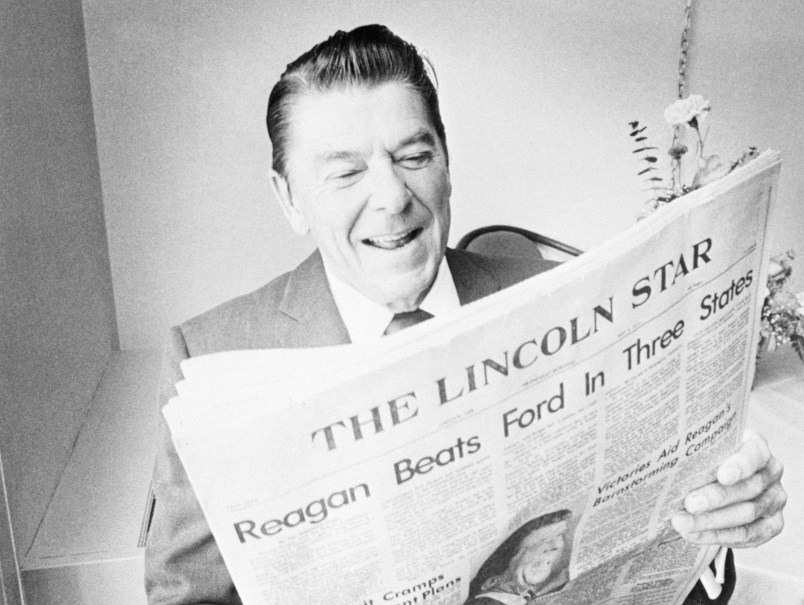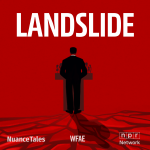This article is part of TPM Cafe, TPM’s home for opinion and news analysis. It is based on the podcast Landslide, which tells the story of how the 1976 primary transformed the Republican Party.
Whiplash-inducing breaks from long-held party positions have become the norm in today’s Republican Party.
From former president Donald Trump to emerging voices such as Senator J.D. Vance, presidential candidate Ron DeSantis, and North Carolina gubernatorial candidate Mark Robinson, a wave of politicians and activists have signaled an abandonment of Republican orthodoxy on issues that once defined the party.
The party of free trade has become protectionist. The party of Cold Warriors has increasingly backed Russia and opposed aiding Ukraine. The party of less government has grown conflicted about where it stands on Social Security and Medicare.
How can not just a party, but its voters, suddenly change direction on so many bedrock issues?
Or have they?
I’ve spent the past two years studying the Right of half a century ago as I researched my historical podcast series Landslide (listen now!), which is part of the NPR Network. I found a different explanation:
This new wave of Republicans is not reversing course. What seems like a shift on fundamental issues is, rather, the latest expression of the same underlying force that has propelled voters for nearly half a century.

“Organizing discontent”
Go back 50 years. Another wave of conservative activists exploded into national politics.
In the mid-1970s, a network of grassroots groups and activists cropped up to battle a range of the era’s social and cultural changes: school integration, new textbooks, gun laws, the women’s rights movement, gay and lesbian rights, and — eventually — abortion.
These groups earned the moniker “the New Right.”
New Right organizations included Phyllis Schlafly’s Eagle Forum and the NRA’s further-right cousin, the Gun Owners of America. It also included many of the same conservative groups that push policy positions and drive national debates today: the Heritage Foundation, the American Legislative Exchange Council, and the National Right-to-Life Committee, to name just a handful. These groups shared many of the same founders. Harper’s Magazine described their organizational charts as “an octopus shaking hands with itself.”
Two elements put the “new” in New Right.
First, these groups relied on one primary — and, at the time, groundbreaking — method to raise money and build support: direct-mail, usually coordinated by a pioneer of political mailings, Richard Viguerie.

Regardless of whether you contributed to the campaign of the race-baiting Alabama governor George Wallace or to an anti-pornography group in New York, you might find yourself in Viguerie’s computerized list, receiving a letter like the following from 1976:
“Your taxes are being used to pay for grade school courses that teach our children that cannibalism, wife swapping and the murder of infants and the elderly are acceptable behavior.”
The letter bore the signature of a U.S. senator, Jesse Helms of North Carolina. The alarmed, apocalyptic tone was a staple of New Right mailings.
“Political inertia is the normal state for most people,” Viguerie wrote in 2004. “It takes a sledgehammer of an issue to distract them from their ball games, shopping sprees, and daily work preoccupations.”
The second, novel element of the New Right was how it organized around social and cultural backlash.
“The New Right,” David Stockman, a conservative congressman, said in 1977, “Emphasizes the social issue, and kind of inflaming passions.”
“The belief seemed to be that there was a vast, untapped electorate that would respond to these appeals,” said Alan Crawford, who worked for Viguerie’s magazine, Conservative Digest and later wrote a book, Thunder on the Right.
The New Right brought seemingly unrelated issues under one umbrella — creating a link between, for instance, opponents of abortion and opponents of gun laws. One New Right leader, Howard Phillips, described the goal as to “organize discontent.”
At a time when the major political parties still typically sought to downplay divisive social and cultural fights, the New Right knit together a coalition from backlash to these issues.
“The nature of American conservatism was being deliberately changed,” Crawford told me. “And they succeeded beyond their wildest dreams.”

Winning a party
It all came to a head in the 1976 election.
My series Landslide explores how that close, bitterly fought presidential race transformed the Republican Party — a transformation driven in large part by the New Right.
It began when a conservative candidate, Ronald Reagan, challenged the unelected incumbent president, Gerald Ford, for the Republican nomination. At stake was the party’s direction. Reagan nearly suffered an embarrassing early exit. He lost the first five primaries. We see today how catastrophic a string of early defeats can prove for a candidate. But just as Reagan’s campaign appeared poised to collapse, New Right groups swept in to save it.
“We are in real danger of being out-organized by a small number of highly motivated right-wing nuts,” a Ford campaign memo worried after Reagan won the Texas primary in May.
Reagan had a comeback. At one point he surpassed Ford and became the frontrunner. The two battled all the way to the Republican National Convention during what became the closest presidential primary race in history.
Over the course of it, Reagan articulated the positions that became GOP orthodoxy — the positions that today’s crop of Republicans reject — the hawkish, interventionist foreign policy and deep spending cuts.
But underneath that rhetoric, Reagan’s campaign was animated by the same force as the New Right: a backlash against social issues and a changing culture.
At the Republican National Convention, Reagan’s delegates pushed new, far-more socially conservative positions into the party platform: opposing abortion, gun laws, and attempts to restrict prayer in public schools, among them.
Reagan concluded his most important ads in 1976 with this message:
“I would like very much to see this country become once again … the kind of country, the free country, that you and I grew up in.”
The message of a better past endangered by a changing culture would not feel out of place coming from Republican candidates today. And, the issues they emphasize — opposing the contents of textbooks, the use of race in school admissions, and transgender rights, among others — are the modern descendants of those 50 years ago.
The wave of Trump-inspired Republicans also have increasingly earned a new moniker: “the New Right.”
Correction: Due to an editing error, this article originally misstated the state where Mark Robinson is running for governor. TPM regrets this error.








Mark Robinson is running for governor in North Carolina, not Virginia as is stated in the article.
Rick Perlstein wrote a great article back in 2012 on the history of this trend. Back then we thought Mitt Romney was the biggest liar we’d ever seen but that was before we were shown there was no bottom, that Republicans could go so low that Mitt could seem like up.
Unlike far too many of my (white) peers, coming of age under Reagan forever turned me against the Republican Party. How the was story arc of Reagan’s GOP so completely obvious to me - a teen-to-twenty-something - and yet so many around me adored the bastard? Including my parents and brothers. Each step, from Reagan to Gingrich to Dubya/Cheney to The Tea Party to Trump … Just f’ing obvious that this was where the cultural right was destined to go.
Trying to repeal the New Deal since the ink on FDR’s signature was drying. It’s disgusting how fundamentally selfish and bullying these people are.
The basis of Populism for centuries.
Look no further than the Know-Nothings of the 1840s!
I think I should finally read Richard Hofstadter’s Paranoid Style.